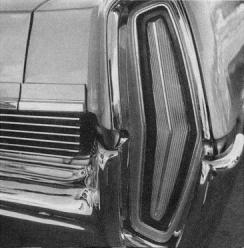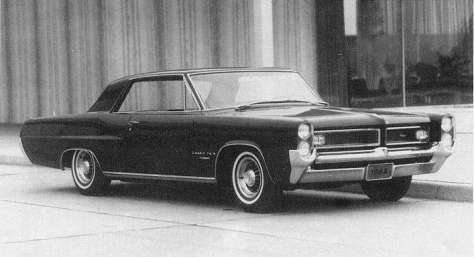| |
 The stylists softened the body lines on the 1964 Grand Prix, frenching both front and rear lights for a more European effect. The result, a
startling departure from the angular design of the previous year, gave the car a much longer, lower, and wider appearance. In fact, it was built on
the same shell. The stylists softened the body lines on the 1964 Grand Prix, frenching both front and rear lights for a more European effect. The result, a
startling departure from the angular design of the previous year, gave the car a much longer, lower, and wider appearance. In fact, it was built on
the same shell.

|
Looking at Pontiac's performance offerings in '64 shows 389- and 421-cubic-inch engines in a variety of power ratings. The first engine option was a 389 Tri-Power with 10.75:1 compression. It kicked out 330 horses at 4600 rpm and 430 lbs.-ft. of torque at 3200.
Next up the ladder was the standard 421 4-barrel. With a slightly lower 10.5:1 compression ratio, this mill developed 320 hp at 4400 rpm and 455 lbs.-ft. of stump-pulling torque at 2800. While this 421 was a full 10 horses down from the 389 Tri-Power, it had 25 lbs.-ft. more torque, maxing out 400 rpm lower in the power range. This engine definitely had more grunt out of the hole than its smaller brother, although the 389 would continue to make power after the 421 ran out of breath. The 421-4V made for a trouble-free middle-of-the-road street performance engine.
When the 421 engine was ordered with the Tri-Power, things really got interesting. There were two versions of this combo, the milder one being a 350-horse version that used the standard camshaft and exhaust manifolds. The top-dog engine was the famous 421 HO, which was good for a very impressive 370 hp at 5200 rpm and 460 lbs.-ft. of torque at 3800. This was a brutal engine, especially when coupled with a 4-speed manual transmission and performance rear axle ratios.
The 1963 X-400 received a major facelift for the 1964 show season. The car was a strong predictor of the look of things to come, as the front-end styling carried over almost intact to the 1966 Grand Prix and GTO. This year's X-400 was painted a dark burgundy and was quite a hit at the International Auto Show in New York City.
Factory records indicate that at least one 1964 Grand Prix four-door was assembled at the Doraville, Ga., plant. Parker Little, a recently retired GM employee who worked there at the time, recalls the car and the circumstances of its manufacture. It seems that the owner of a large Miami Pontiac dealership fell in love with the styling of the '64 GP, but his wife didn't like it because it was only available as a two-door. It just so happened that this dealer was good friends with then-GM president Elliott M. "Pete" Estes. Estes used his considerable influence to push the order through corporate red tape, and a Catalina hardtop was trimmed out as a GP.
"Some temporary tooling had to be constructed to build the car, mostly for the interior," Little recalls. This unique GP had custom front and rear door panels and rear seat cushions. It also sported bucket seats, a console, and, as Little adds, "was loaded in all respects." It is not clear as to what was under the hood of the car. The car's fate also remains a mystery, but as information comes in, we will update this story.
Sales of Grand Prixs dropped about 10,000 units in '64 to 63,810. This was partially due to the introduction of the Catalina 2+2, a sports coupe/convertible that crowded the GP in terms of price when heavily optioned. Also, the competition was starting to catch up in the personal luxury market, and the new-bodied '64 T-Bird sold a whopping 92,465 units. Other cars in the GP's class also ate into its sales a bit. Chrysler's 300 and Buick's Riviera were not doing as well as the Grand Prix, and while Oldsmobile's Starfire and Jetstar I posed little threat to the GP by themselves, put it all together and there were enough slower-selling cars on the market to take a collective bite out of GP sales.
NEXT >
|
|